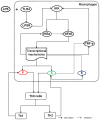Agent-based modeling of endotoxin-induced acute inflammatory response in human blood leukocytes
- PMID: 20174629
- PMCID: PMC2823776
- DOI: 10.1371/journal.pone.0009249
Agent-based modeling of endotoxin-induced acute inflammatory response in human blood leukocytes
Abstract
Background: Inflammation is a highly complex biological response evoked by many stimuli. A persistent challenge in modeling this dynamic process has been the (nonlinear) nature of the response that precludes the single-variable assumption. Systems-based approaches offer a promising possibility for understanding inflammation in its homeostatic context. In order to study the underlying complexity of the acute inflammatory response, an agent-based framework is developed that models the emerging host response as the outcome of orchestrated interactions associated with intricate signaling cascades and intercellular immune system interactions.
Methodology/principal findings: An agent-based modeling (ABM) framework is proposed to study the nonlinear dynamics of acute human inflammation. The model is implemented using NetLogo software. Interacting agents involve either inflammation-specific molecules or cells essential for the propagation of the inflammatory reaction across the system. Spatial orientation of molecule interactions involved in signaling cascades coupled with the cellular heterogeneity are further taken into account. The proposed in silico model is evaluated through its ability to successfully reproduce a self-limited inflammatory response as well as a series of scenarios indicative of the nonlinear dynamics of the response. Such scenarios involve either a persistent (non)infectious response or innate immune tolerance and potentiation effects followed by perturbations in intracellular signaling molecules and cascades.
Conclusions/significance: The ABM framework developed in this study provides insight on the stochastic interactions of the mediators involved in the propagation of endotoxin signaling at the cellular response level. The simulation results are in accordance with our prior research effort associated with the development of deterministic human inflammation models that include transcriptional dynamics, signaling, and physiological components. The hypothetical scenarios explored in this study would potentially improve our understanding of how manipulating the behavior of the molecular species could manifest into emergent behavior of the overall system.
Conflict of interest statement
Figures









Similar articles
-
Modeling endotoxin-induced systemic inflammation using an indirect response approach.Math Biosci. 2009 Jan;217(1):27-42. doi: 10.1016/j.mbs.2008.09.003. Epub 2008 Sep 20. Math Biosci. 2009. PMID: 18840451 Free PMC article.
-
A model of TLR4 signaling and tolerance using a qualitative, particle-event-based method: introduction of spatially configured stochastic reaction chambers (SCSRC).Math Biosci. 2009 Jan;217(1):43-52. doi: 10.1016/j.mbs.2008.10.001. Epub 2008 Oct 11. Math Biosci. 2009. PMID: 18950646
-
The presence of LPS in OVA inhalations affects airway inflammation and AHR but not remodeling in a rodent model of asthma.Am J Physiol Lung Cell Mol Physiol. 2012 Jul 1;303(1):L54-63. doi: 10.1152/ajplung.00208.2011. Epub 2012 Apr 20. Am J Physiol Lung Cell Mol Physiol. 2012. PMID: 22523281
-
Immunological Approaches Towards Cancer and Inflammation: A Cross Talk.Front Immunol. 2018 Mar 20;9:563. doi: 10.3389/fimmu.2018.00563. eCollection 2018. Front Immunol. 2018. PMID: 29662489 Free PMC article. Review.
-
Toll-like receptor signaling and regulation of cytokine gene expression in the immune system.Biotechniques. 2002 Oct;Suppl:66-8, 70, 72 passim. Biotechniques. 2002. PMID: 12395929 Review.
Cited by
-
Agent-based modeling of the immune system: NetLogo, a promising framework.Biomed Res Int. 2014;2014:907171. doi: 10.1155/2014/907171. Epub 2014 Apr 22. Biomed Res Int. 2014. PMID: 24864263 Free PMC article.
-
Automated parameter estimation for biological models using Bayesian statistical model checking.BMC Bioinformatics. 2015;16 Suppl 17(Suppl 17):S8. doi: 10.1186/1471-2105-16-S17-S8. Epub 2015 Dec 7. BMC Bioinformatics. 2015. PMID: 26679759 Free PMC article.
-
Bridging Systems Medicine and Patient Needs.CPT Pharmacometrics Syst Pharmacol. 2015 Mar;4(3):e00026. doi: 10.1002/psp4.26. Epub 2015 Mar 27. CPT Pharmacometrics Syst Pharmacol. 2015. PMID: 26225243 Free PMC article. Review.
-
Multiscale Agent-Based and Hybrid Modeling of the Tumor Immune Microenvironment.Processes (Basel). 2019 Jan;7(1):37. doi: 10.3390/pr7010037. Epub 2019 Jan 13. Processes (Basel). 2019. PMID: 30701168 Free PMC article.
-
Regulation of RNA-binding proteins affinity to export receptors enables the nuclear basket proteins to distinguish and retain aberrant mRNAs.Sci Rep. 2016 Nov 2;6:35380. doi: 10.1038/srep35380. Sci Rep. 2016. PMID: 27805000 Free PMC article.
References
-
- Hotchkiss RS, Karl IE. The pathophysiology and treatment of sepsis. N Engl J Med. 2003;348:138–150. - PubMed
-
- Bone RC, Balk RA, Cerra FB, Dellinger RP, Fein AM, et al. Definitions for sepsis and organ failure and guidelines for the use of innovative therapies in sepsis. The ACCP/SCCM Consensus Conference Committee. American College of Chest Physicians/Society of Critical Care Medicine. Chest. 1992;101:1644–1655. - PubMed
-
- Tetta C, Fonsato V, Ronco C, Camussi G. Recent insights into the pathogenesis of severe sepsis. Crit Care Resusc. 2005;7:32–39. - PubMed
-
- Klaitman V, Almog Y. Corticosteroids in sepsis: a new concept for an old drug. Isr Med Assoc J. 2003;5:51–55. - PubMed
Publication types
MeSH terms
Substances
Grants and funding
LinkOut - more resources
Full Text Sources

